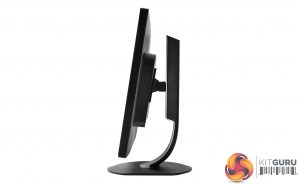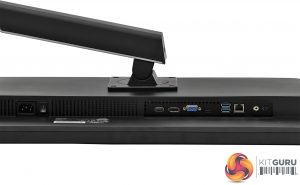The Philips Brilliance 328P6AUBREB comes in the white box we usually see with screens from this company.
You get a full set of wiring inside. There are cables for every single type of display connectivity, including DisplayPort, HDMI, D-Sub and two different types of USB-C. One is from Type C to Type C, the other ends in Type A, should you need to use the USB hub with a computer that doesn't have a Type C connection.
There's also a minijack audio connection, and of course the obligatory power cable. The power supply is built into the screen itself.
Philips injects a little bit of style into this screen with the silver stand arm and silver inlay along the bottom of the bezel, although the bezel itself is quite thick by today's standards. Overall, though, this is a sober-looking display. Not clunky, but distinctly businesslike.
The 328P6AUBREB has a good range of physical adjustments available. Its height can be raised or lowered through a 180mm range, and it can swivel 170 degrees in either direction. You can also tilt it five degrees forward or 20 degrees back, and swivel the whole screen around into portrait mode.
All the connections to the 328P6AUBREB are on the rear on a slightly recessed panel. The two audio minijacks for headphones and analog input are on the left (when looking from the front), then the mysterious RJ45 port, followed by two USB 3.0 connections and the all-important USB-C port. Then there's VGA, DisplayPort 1.2 and HDMI 2.0.
It's a shame that both the USB downstream ports are tucked away on the back, but they are clearly aimed at permanently connecting a mouse and keyboard, not USB memory keys.
It should be noted that the USB-C port has more than one function. Not only can it act as the upstream connection for audio, peripherals and video signals, it can also provide charge to a connected laptop. So if your laptop can charge over USB-C as well as output video, you're really in luck, as you won't even need your power adapter. One cable will do it all. However, we didn't have a compatible laptop to hand to test this.
The OSD control buttons are marked on the front, but they're not actually physical buttons. They're touch-sensitive zones that can be accessed by tapping on the front or underneath. This is a little unintuitive at first, where you might be expecting real buttons. But it's a reasonably comfy system once you're used to it.
 KitGuru KitGuru.net – Tech News | Hardware News | Hardware Reviews | IOS | Mobile | Gaming | Graphics Cards
KitGuru KitGuru.net – Tech News | Hardware News | Hardware Reviews | IOS | Mobile | Gaming | Graphics Cards



















